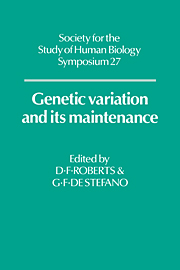Book contents
- Frontmatter
- Contents
- Preface
- Part I Genetic Diversity - Its Dimensions
- Part II Genetic Diversity - Its Origin and Maintenance
- Human genetic diversity in south-east Asia and the western Pacific
- Malaria-protective alleles in southern Africa: relict alleles of no health significance
- The genetic origin of the variability of the phenotypic expression of the Hb S gene
- Origin and maintenance of genetic variation in Black Carib populations of St. Vincent and Central America
- Historical and demographic factors and the genetic structure of an Afro-American Community of Nicaragua
- Migration and genetic polymorphisms in some Congo peoples
- Population structure studies and genetic variability in humans
- Inbreeding and the incidence of recessive disorders in the populations of Karnataka, South India
- Genetic diversity at the albumin locus
- GENETIC DIVERSITY - APPLICATIONS AND PROBLEMS OF COMPLEX CHARACTERS
- Index
Inbreeding and the incidence of recessive disorders in the populations of Karnataka, South India
Published online by Cambridge University Press: 05 March 2012
- Frontmatter
- Contents
- Preface
- Part I Genetic Diversity - Its Dimensions
- Part II Genetic Diversity - Its Origin and Maintenance
- Human genetic diversity in south-east Asia and the western Pacific
- Malaria-protective alleles in southern Africa: relict alleles of no health significance
- The genetic origin of the variability of the phenotypic expression of the Hb S gene
- Origin and maintenance of genetic variation in Black Carib populations of St. Vincent and Central America
- Historical and demographic factors and the genetic structure of an Afro-American Community of Nicaragua
- Migration and genetic polymorphisms in some Congo peoples
- Population structure studies and genetic variability in humans
- Inbreeding and the incidence of recessive disorders in the populations of Karnataka, South India
- Genetic diversity at the albumin locus
- GENETIC DIVERSITY - APPLICATIONS AND PROBLEMS OF COMPLEX CHARACTERS
- Index
Summary
INTRODUCTION
While it is generally accepted that inbreeding in humans can lead to increased incidences of genetically-determined abnormalities, due to the expression of rare, deleterious, recessive genes in the homozygous state, consanguineous marriages are common in many communities, for example, the four southern states of India, Andhra Pradesh, Karnataka, Kerala and Tamil Nadu (Kumar et al, 1967; Rao & Inbaraj, 1977a; Rami Reddy & Chandrasekhar Reddy, 1979; Radha Rama Devi et al, 1981). Although infectious diseases and nutritional disorders are still common in India, their incidences have declined markedly during the last twenty years. Therefore it seems probable that among the populations of South India (Fig. 1), which in the 1981 Census totalled over 164 millions, a transition from an almost exclusively environmental to an increasingly genetic pattern of disease is currently under way, similar to that earlier observed in countries such as Great Britain (Roberts et al, 1970). However the emerging situation in the South Indian states almost certainly will be of greater complexity than in Western countries because of the long inbreeding tradition. Indeed, it has been suggested that the high levels of inbreeding practised by the Dravidian peoples for at least 2,000 years (Centerwall et al, 1969) would have led to the gradual elimination of deleterious lethals and sublethals from the gene pool by segregation (Sanghvi, 1966). This theory has been questioned (Chakraborty & Chakravarti, 1977; Bittles, 1980) but supporting evidence was claimed in large-scale prospective and retrospective studies conducted in Tamil Nadu (Rao & Inbaraj, 1977b, 1979a,b, 1980).
- Type
- Chapter
- Information
- Genetic Variation and its Maintenance , pp. 221 - 228Publisher: Cambridge University PressPrint publication year: 1986
- 1
- Cited by



